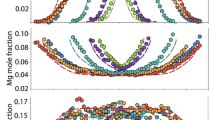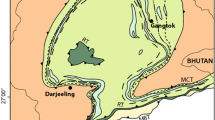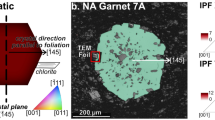Abstract
Garnet-bearing schists from the Waterville Formation of south-central Maine provide an opportunity to examine the factors governing porphyroblast size over a range of metamorphic grade. Three-dimensional sizes and locations for all garnet porphyroblasts were determined for three samples along the metamorphic field gradient spanning lowest garnet through sillimanite grade, using high-resolution X-ray computed tomography. Comparison of crystal size distributions to previous data sets obtained by stereological methods for the same samples reveals significant differences in mode, mean, and shape of the distributions. Quantitative textural analysis shows that the garnets in each rock crystallized in a diffusion-controlled nucleation and growth regime. In contrast to the typical observation of a correlation between porphyroblast size and position along a metamorphic field gradient, porphyroblast size of the lowest-grade specimen is intermediate between the high- and middle-grade specimens’ sizes. Mean porphyroblast size does not correlate with peak temperatures from garnet-biotite Fe-Mg exchange thermometry, nor is post-crystallization annealing (Ostwald Ripening) required to produce the observed textures, as was previously proposed for these rocks. Robust pseudosection calculations fail to reproduce the observed garnet core compositions for two specimens, suggesting that these calc-pelites experienced metasomatism. For each of these two specimens, Monte Carlo calculations suggest potential pre-metasomatism bulk compositions that replicate garnet core compositions. Pseudosection analyses allow the estimation of the critical temperatures for garnet growth: ∼481, ∼477, and ∼485°C for the lowest-garnet-zone, middle-garnet-zone, and sillimanite-zone specimens, respectively. Porphyroblast size appears to be determined in this case by a combination of the heating rate during garnet crystallization, the critical temperature for the garnet-forming reaction and the kinetics of nucleation. Numerical simulations of thermally accelerated, diffusion-controlled nucleation, and growth for the three samples closely match measured crystal size distributions. These observations and simulations suggest that previous hypotheses linking the garnet size primarily to the temperature at the onset of porphyroblast nucleation can only partially explain the observed textures. Also important in determining porphyroblast size are the heating rate and the distribution of favorable nucleation sites.







Similar content being viewed by others
References
Barker DS (1961) Hallowell granite and associated rocks, South-Central Maine. Unpublished Ph.D. Thesis, Princeton University, Princeton, p 240
Berman RG (1990) Mixing properties of Ca-Mg-Fe-Mn garnets. Am Mineral 75:328–344
Carlson WD (1989) The significance of intergranular diffusion to the mechanisms and kinetics of porphyroblast crystallization. Contrib Mineral Petrol 103:1–24
Carlson WD (1999) The case against Ostwald ripening of porphyroblasts. Can Mineral 37:403–413
Carlson WD, Denison C, Ketcham RA (1995) Controls on the nucleation and growth of porphyroblasts; kinetics from natural textures and numerical models. Geol J 30(3–4):207–225
Cashman KV, Ferry JM (1988) Crystal size distribution (CSD) in rocks and the kinetics and dynamics of crystallization. Contrib Mineral Petrol 99:401–415
Connolly JAD (1990) Multivariable phase diagrams: an algorithm based on generalized thermodynamics. Am J Sci 290(6):666–718
Connolly JAD, Petrini K (2002) An automated strategy for calculation of phase diagram sections and retrieval of rock properties as a function of physical conditions. J Metamorphic Geol 20(7):697–708
De Yoreo JJ, Lux DR, Guidotti CV, Decker ER, Osberg PH (1989) The Acadian thermal history of western Maine. J Metamorphic Geol 7(2):169–190
Denison C, Carlson WD, Ketcham RA (1997) Three-dimensional quantitative textural analysis of metamorphic rocks using high-resolution computed X-ray tomography. Part I: methods and techniques. J Metamorphic Geol 15(1):29–44
Farver JR, Yund RA (1998) Bulk diffusion of selected cations in a natural quartz aggregate. Eos 79(17):369
Ferry JM (1980) A comparative study of geothermometers and geobarometers in pelitic schists from South-central Maine. Am Mineral 65(7–8):720–732
Ferry JM (1982) A comparative geochemical study of pelitic schists and metamorphosed carbonate rocks from south-central Maine, USA. Contrib Mineral Petrol 80(1):59–72
Ferry JM (1984) A biotite isograd in south-central Maine, USA; mineral reactions, fluid transfer, and heat transfer. J Petrol 25(4):871–893
Ferry JM, Rumble III D, Wing BA, Penniston-Dorland SC (2005) A new interpretation of centimetre-scale variations in the progress of infiltration-driven metamorphic reactions: case study of carbonated metaperidotite, Val d’Efra, Central Alps, Switzerland. J Petrol 46(8):1725–1746
Ferry JM, Spear FS (1978) Experimental calibration of the partitioning of Fe and Mg between biotite and garnet. Contrib Mineral Petrol 66:113–117
Fisher GW (1978) Rate laws in metamorphism. Geochimica et Cosmochimica Acta 42(7):1035–1050
Hirsch D (2003) The heat-flow controlled crystallization of extremely large andalusite porphyroblasts, Picuris Mountains, NM, USA. Geological Association of Canada Abstracts with Programs 28
Hirsch DM, Ketcham RA, Carlson WD (2000) An evaluation of spatial correlation functions in textural analysis of metamorphic rocks. Geol Mater Res 2(3):1–41
Hodges KV, Spear FS (1982) Geothermometry, geobarometry and the Al2SiO5 triple point at Mt. Moosilauke, New Hampshire. Am Mineral 67(11–12):1118–1134
Holdaway MJ (1971) Stability of andalusite and the aluminum silicate phase diagram. Am J Sci 271:97–131
Holdaway MJ (2000) Application of new experimental and garnet Margules data to the garnet-biotite geothermometer. Am Mineral 85(7):881–892
Holdaway MJ, Guidotti CV, Novak JM, Henry WE (1982) Polymetamorphism in medium-to high-grade pelitic metamorphic rocks, West-central Maine. Bull Geol Soc Am 93(7):572–584
Holland T, Baker J, Powell R (1998) Mixing properties and activity-composition relationships of chlorites in the system MgO-FeO-Al2O3-SiO2-H2O. Eur J Mineral 10(3):395–406
Holland TJB, Powell R (1998) An internally consistent thermodynamic data set for phases of petrological interest. J Metamorphic Geol 16(3):309–343
Hollister LS (1966) Garnet zoning: an interpretation based on the Rayleigh fractionation model. Science 154:1647–1651
Ketcham RA (2005) Computational methods for quantitative analysis of three-dimensional features in geological specimens. Geosphere 1(1):32–41
Ketcham RA, Meth C, Hirsch D, Carlson WD (2005) Improved methods for quantitative analysis of three-dimensional porphyroblastic features. Geosphere 1(1):42–59
Kretz R (1973) Kinetics of the crystallization of garnet at two localities near Yellowknife. Can Mineral 12:1–20
Kretz R (1974) Some models for the rate of crystallization of garnet in metamorphic rocks. Lithos 7(3):123–131
Kretz R (1983) Symbols for rock-forming minerals. Am Mineral 68(1–2):277–279
Penniston-Dorland SC, Ferry JM (2006) Development of spatial variations in reaction progress during regional metamorphism of micaceous carbonate rocks, Northern New England. Am J Sci 306(7):475
Perchuk LL, Lavrent’eva IV (1983) Experimental investigation of exchange equilibria in the system cordierite-garnet-biotite. In: Saxena SK (ed) Kinetics and equilibrium in mineral reactions, vol 3. Springer, New York, pp 199–239
Porter DA, Easterling KE (1992) Phase transformations in metals and alloys. Chapman & Hall, London, p 514
Powell R, Holland TJB (1999) Relating formulations of the thermodynamics of mineral solid solutions: activity modeling of pyroxenes, amphiboles, and micas. Am Mineral 84(1–2):1–14
Saltykov SA (1967) The determination of the size distribution of particles in an opaque material from a measurement of the size distribution of their sections. In: Elias H (ed) Stereology, Proceedings of the 2nd international congress for stereology, Springer, New York, p 163
Spry A (1969) Metamorphic textures. Pergamon Press, Oxford, p 350
Acknowledgments
This research would not have been possible without the generous offer of specimens from John Ferry of John’s Hopkins University. High resolution X-ray Computed Tomography for this work was conducted at the University of Texas CT Facility, now supported by NSF EAR-0646848. Portions of the research were supported by grants from the Office of Research and Sponsored Programs at Western Washington University. The manuscript was greatly improved by discussions with W. D. Carlson as well as thoughtful and helpful reviews by John Ferry and Chris Daniel.
Author information
Authors and Affiliations
Corresponding author
Additional information
Communicated by T.L. Grove.
Rights and permissions
About this article
Cite this article
Hirsch, D.M. Controls on porphyroblast size along a regional metamorphic field gradient. Contrib Mineral Petrol 155, 401–415 (2008). https://doi.org/10.1007/s00410-007-0248-y
Received:
Accepted:
Published:
Issue Date:
DOI: https://doi.org/10.1007/s00410-007-0248-y




